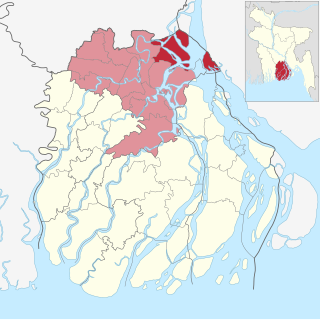
Barisal Division is one of the eight administrative divisions of Bangladesh. Located in the south-central part of the country, it has an area of 13,225 km2 (5,106 sq mi), and a population of 9,325,820 at the 2022 Census. It is the least populous Division in Bangladesh. It is bounded by Dhaka Division on the north, the Bay of Bengal on the south, Chittagong Division on the east and Khulna Division on the west. The administrative capital, Barisal city, lies in the Padma River delta on an offshoot of the Arial Khan River. Barisal division is criss-crossed by numerous rivers that earned it the nickname Dhan-Nodi-Khal, Ei tin-e Borishal.

Bhola District is an administrative district (zila) in south-central Bangladesh, which includes Bhola Island, the largest island of Bangladesh. It is located in the Barisal Division and has an area of 3,403.48 km2. It is bounded by Lakshmipur and Barisal District to the north, the Bay of Bengal to the south, by Lakshmipur and Noakhali districts, the (lower) Meghna river and Shahbazpur Channel to the east, and by Patuakhali District and the Tetulia river to the west. About 400 million cubic feet natural gas has been found at Kachia in Bhola which is being used to run a power station.

Barguna is a district in the division of Barisal, in southern Bangladesh. Barguna subdivision was established in 1969 and promoted to a district on 28 February 1984.

Pirojpur is a district (zilla) in south-western Bangladesh. It is a part of Barisal Division.

Patuakhali is a district in south-central Bangladesh in the Barisal Division. This district is the main entrance for the beach of Kuakata.

Jhalokati, also spelled Jhalokathi, is a district in southern Bangladesh. It is located in the Barisal Division and covers an area of 758.06 km2 It is bounded by Barisal district to the north, Barguna district to the east and the Bishkhali river in the south, and Pirojpur district to the west. The main rivers in this district are the Bishkhali, Dhanshiri, Gabkhan, Sugandha, Jangalia, Bamanda and Bajitpur. "পেয়ারা আর শীতলপাটি, এই নিয়ে ঝালকাঠি" "(Jhalokathi, The land of tasty Guava and Shitolpati)" is the official motto of the district.

Barisal, officially known as Barishal, is a major city that lies on the banks of the Kirtankhola river in south-central Bangladesh. It is the largest city and the administrative headquarter of both Barisal District and Barisal Division. It is one of the oldest municipalities and river ports of the country. The city was once called the Venice of the East or the Venice of Bengal.

Barguna is a town in Barguna district in southern Bangladesh. It is the administrative headquarter and the largest town of Barguna district and a part of Barisal Division. Located on the bank of Khakdon river, the town covers an area of 15.57 square kilometres (6.01 sq mi) with a population of 32,235, as of the 2011 census.
Altaf Mahmud was a musician, cultural activist, and martyred freedom fighter of the Bangladesh Liberation War. He was also a language activist of the Language Movement and composer of "Amar Bhaier Rokte Rangano", the famous song written to commemorate the event.

Agailjhara is an upazila (sub-district) of southern Bangladesh's Barisal District, part of the Barisal Division.

Babuganj is an administrative unit of Barisal District in the Division of Barisal, Bangladesh.

Banaripara is an upazila of Barishal District in the Division of Barishal in southern-central Bangladesh.

Hizla is the largest upazila (sub-district) of southern Bangladesh's Barisal District.

Mehendigonj is an upazila of Barisal District in Barisal Division, Bangladesh. Mehendigonj is popularly known as Patarhat by the local people.

Muladi is an upazila of Barishal District in the Division of Barishal, Bangladesh.

Jhalakathi Sadar is an upazila of Jhalokati District in the Division of Barisal, Bangladesh.

Rajapur is an upazila (sub-district) of southern Bangladesh's Jhalokati District, part of the Barisal Division.
Ulania is a union parishad of Mehendiganj Upazila in Barisal District, Barisal Division, Bangladesh.

Backergunge, Backergunje, Bakarganj, or Bakerganj is a former district of British Bengal, East Pakistan and Bangladesh. It was the southernmost district of the Dacca Division. The district was located in the swampy lowlands of the vast delta of the Ganges and the Brahmaputra rivers.

Khan BahadurHashim Ali Khan was a Bengali politician, lawyer, peasant movement leader and social worker. He was a close associate of A. K. Fazlul Huq. He became a Minister in the Bengal Legislature in 1941 in the second cabinet led by Huq. During his political life, he tried to establish rights of farmers and common people. He was conferred the title of Khan Bahadur by the British Raj as recognition of his contribution for maintaining peaceful relations between people of different faiths.































